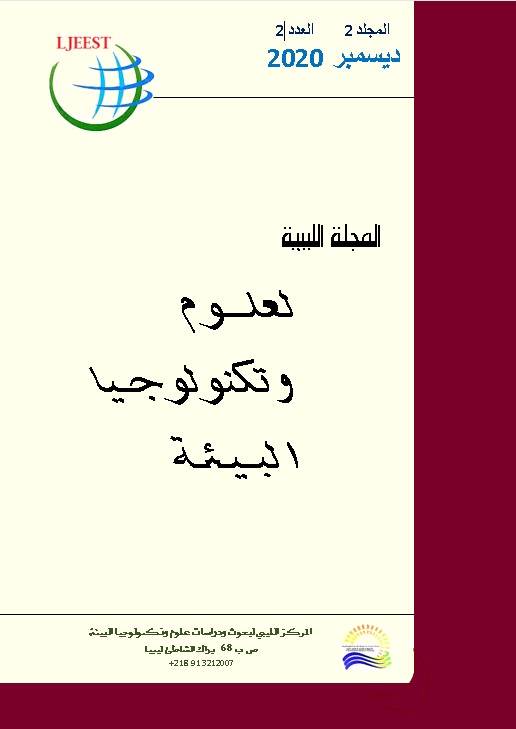معالجة مياه الصرف الصحي في مدينة بن وليد بتقنية المفاعلات اللاهوائية (UASB).
DOI:
https://doi.org/10.63359/k7swx033الكلمات المفتاحية:
بطانية الحمأة اللاهوائية ذات التدفق العالي (UASB)، الطلب على الأكسجين الكيميائي (COD)، وقت الاحتفاظ الهيدروليكي (HRT)، معدل التحميل العضوي (OLR)، إجمالي المواد الصلبة العالقة (TSS)الملخص
تفتقر ليبيا إلى مرافق معالجة مياه الصرف الصحي ويتم تصريف مياه الصرف الصحي بالكامل تقريبًا دون معالجة في البحر أو الردم في المناطق المفتوحة يتطلب هذا الموقف معالجة مياه الصرف الصحي باستخدام تقنيات المفاعلات اللاهوائية البسيطة والفعالة من حيث التكلفة والمتوافقة مع الظروف المحلية حيث تتم في هذه الطريقة معالجة المياه وانتاج غاز الميثان كمصدر للطاقة. الهدف العام من هذا البحث هو تحديد خصائص مياه الصرف الصحي لمدينة بني وليد وتقييم أداء مفاعلات UASB لمعالجة هذه مياه.أظهرت النتائج المتحصل عليها أن مفاعلات UASB التي تعمل في درجات حرارة المحيطة كانت فعالة للغاية في معالجة المياه العادمة بتركيز COD المؤثر 629 مجم/ لتر في HRT من 24 إلى 6 ساعات مع إنتاج غازالميثان الذي تم الحصول عليه كان حوالي 0.32 لتر/ CH4 جم COD كانت كفاءة إزالة COD عالية عند 95٪ وكان إجمالي إزالة المواد الصلبة العالقة حوالي 95٪.
المراجع
Ali, M. A. G. (2020). Problems encountered during the start-up of up flow anaerobic sludge blanket reactors (UASB) at 20 ⁰C & 15 ⁰C. Advances in Food Science, Sustainable Agriculture and Agroindustrial Engineering (AFSSAAE), 3(1), 32-39.
Ali, M. A. G, “Energy recovery from treatment of a synthetic municipal-type wastewater in UASB reactors at ambient temperatures and elevated sulphate concentrations” PhD thesis, Faculty of Engineering and the Environment. UNIVERSITY OF SOUTHAMPTON, 2014.
Alvarez, J. A., Ruiz, I., Gómez, M., Presas, J., & Soto, M. (2006). Start-up alternatives and performance of an UASB pilot plant treating diluted municipal wastewater at low temperature. Bioresource Technology, 97(14), 1640-1649.
APHA (2005). Standard methods for the examination of water and wastewater. 21st edition, American Public Health Association, American Water Works Association, Water Environment Federation, Washington DC, USA.
Cavalcanti, P. F. F., Medeiros, E. J. S., Silva, J. K.M. and van Haandel, A. (1999). Excess Sludge Discharge Frequency for UASB reactors. Water Science and Technology. 40(8):211-219.
Cronin, C., and. Lo, K. (1998). Anaerobic treatment of brewery wastewater using UASB reactors seeded with activated sludge. Bioresource Technology 64(1): 33-38.
Henze, M. and Ledin, A. (2001). Types characteristics and quantities of classic, combined domestic wastewaters, in Decentralized sanitation and reuse. Concepts, systems and implementation, Lens, P., Zeeman, G., and Letting, G., eds., chapter 4, IWA Publishing, London, UK, 57-72.
Hulshoff Pol W.L., Lens P.N.L, Stams A.J.M. and Lettinga G. (1998) Anaerobic treatment of sulphate rich wastewater. Biodegrad., 9, 213-224.
Kalogo, Y. and Verstraete, W. (1999). Development of anaerobic sludge bed reactor technologies for domestic wastewater treatment: motives and perspectives. World Journal of Microbiology & Biotechnology, 15, 523-534.
Lettinga, G., & Pol, L. H. (1991). UASB-Process Design for Various Types of Wastewaters. Water Science & Technology, 24(8), 87-107.
Loutfy, N. M. (2011). Reuse of wastewater in Mediterranean Region, Egyptian experience. Waste Water Treatment and Reuse in the Mediterranean Region, Springer: 183-213. Pescod, M. (1992). Wastewater treatment and use in agriculture-FAO irrigation and drainage paper 47. Food and Agriculture Organization, Rome.
Mahmoud, N.J.A.-H. (2002). Anaerobic pre-treatment of sewage under low temperature (15 °C) conditions in an integrated UASB-digester system. Ph.D. Thesis. Wageningen University
Metcalf & Eddy (2003) Wastewater engineering: Treatment and reuse (4th ed.).Ed. G. Tchobanoglous, F.L. Burton, H. D. Stensel. Boston, McGraw-Hill.
Noykova, N., et al. (2002). Quantitative analyses of anaerobic wastewater treatment processes: identifiability and parameter estimation. Biotechnology and Bioengineering 78(1): 89-103.
Pescod, M. (1992). Wastewater treatment and use in agriculture-FAO irrigation and drainage paper 47. Food and Agriculture Organization, Rome.
Sharma, Y., & Kaur, K. (2016). Determination of Nitrates and Sulphates in Water of Barnala Region India and Their Harmful Effects on Human Lives. International Journal of Advanced research in Education and Technology, 3(3), 79-82.
Tiwari, M. K., et al. (2006). Influence of extrinsic factors on granulation in UASB reactor. Applied Microbiology and Biotechnology 71(2): 145-154.
Vieira, S. M. M. and Garcia Jr., A. D. (1992). Sewage treatment by UASB-reactor. Operation results and recommendations for design and utilization. Water Science and Technology, 25(7),143-157.
Walker, M., et al. (2009). Potential errors in the quantitative evaluation of biogas production in anaerobic digestion processes. Bioresour Technol 100(24): 6339-6346.















